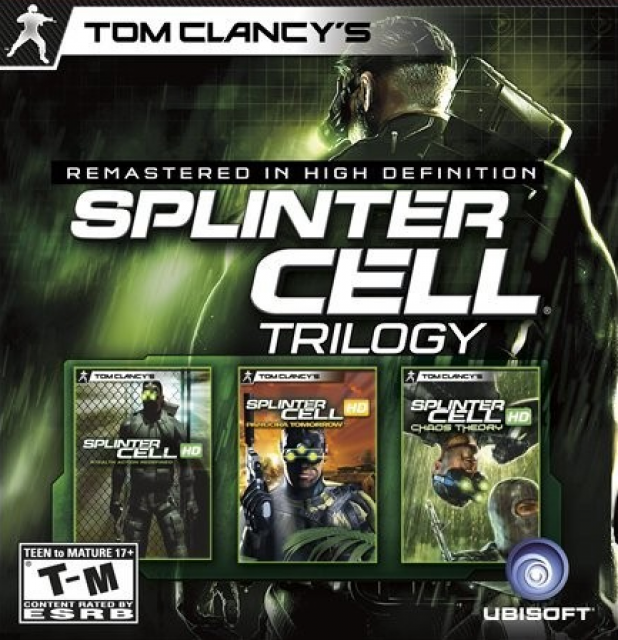Splinter Cell: Chaos Theory (HD Remake)
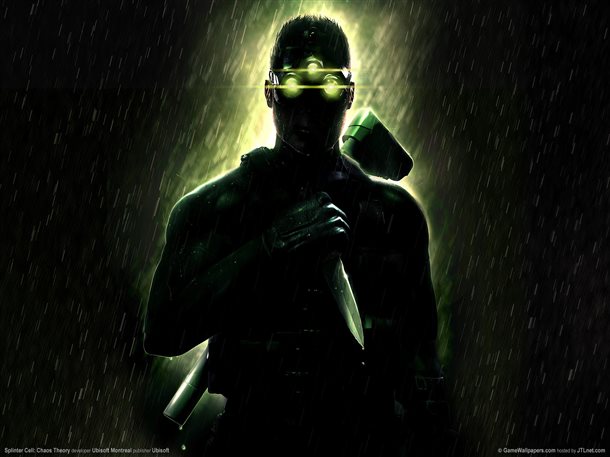
Hey here’s that Splinter Cell: Chaos Theory review in 2015 that everybody’s been clamoring for.
You are Sam Fisher, voiced by the honey-whiskey-and-nails vocal chords resting within Michael Ironside’s talented throat. As part of the super-duper-secret intelligence organization, Third Echelon, you are sent out on sensitive missions to sneak behind and around many men in camo army fatigues, complete your objective, and scoot out as though you were never there to begin with. Ideally, you are – as the game is fond of reminding you – “a ghost’s shadow.”
The writing is one of the strong points of the game. Actually, it’s one of my favorite parts of the game. It’s witty, but only when appropriate. Sam Fisher and his handlers only crack jokes from the safety of the shadows, and always nail them. The character dialogue in this game legitimately cracked me up. They’re all so damn pithy and dry. I love it. It's not all fun and games, though. These characters they also get annoyed with each other. They get mad, have disagreements. Somehow, the writers gave these folks a legitimate work relationship within the insane confines of what they all actually do in this fictional world. It’s an often relieving touch that helps relax a game that so relentlessly demands the utmost attention from the player. The narrative Powers That B also execute rather well on delivering dialogic rewards that anticipate the player’s actions, á la GTA or Max Payne. Do you know what I love? Games that have the confidence in themselves to put in content – and this is good, capital-K Kontent – that some players will flat-out never see. I like to experiment, so I got to experience many conversations that took place when I did – or did not – trigger certain events, but these player-predictive nougats appeared with enough frequency that I’m almost positive that there’s still dialogue that I missed.[1]
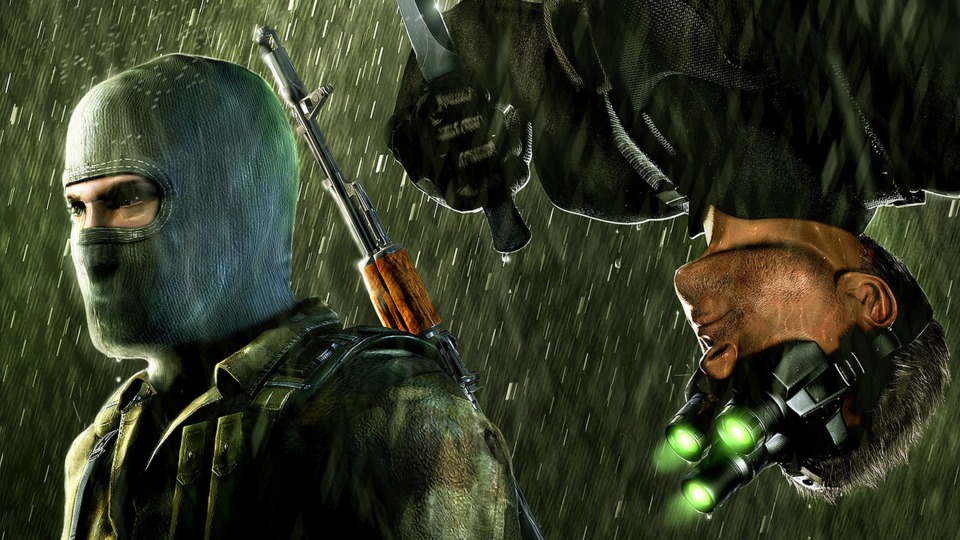
If it’s not quite clear yet, the takeaway here is that I’m a huge fan of the moment-to-moment writing in this game. It’s witty, serious, or informative when it needs to be, and every sentence manages to feel organic. Perhaps playing so many video games has made me lower my standards,[2] but I really appreciate it when every bit of dialogue has been put through the ringer so that I don’t feel uncomfortable when a respectable voice actor forces themselves to choke out a schlocky, awkward line. Normally, I wouldn’t dedicate 500-ish words to the dialogue in a game – let alone 250 – but I truly believe that Chaos Theory has some of my favorite character-driven moments in my recent play history. As such, I wanted to drive home how much this contributed to my enjoyment of the game. If you enjoy games like Uncharted for the well-written character moments that snuggle within the bombast, then I urge you to pick up this title.
Chaos Theory also delivers on a broader note with its narrative. It integrates pieces of the previous two entries into the latest installment, but without the insufferable, forced, wink-wink-look-we’re-being-self-referential-love-us song and dance that so many video games pull. Some of the tech that you – the player – directly interacted with in previous titles comes back into play, propelling the story in a meaningful way. It’s clear that the people that wrote this game played the first two, and actually cared about them. This is good, this is nice. It makes for a smarter story, whose buildup and climax feels like it has been quietly increasing for several games. A lot of this buildup is pulpy, yes, but in a charming way. Like a good, inoffensive political spy thriller.[3] Like a Tom Clancy novel.
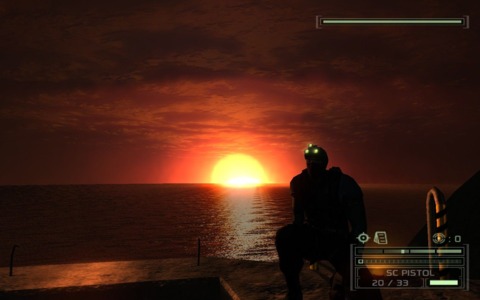
From a visual standpoint, Chaos Theory is crushing it. The HD re-release adds a crisp, defined look to what were once muddy shapes and textures, which actually assists the player with accurately navigating each space. It’s easier to tell whether you’re hidden in the shadows when you can tell where they begin, end, and bleed into the often deadly light. The globe-trotting allows for the designers to play around with some fun and interesting locals, each of which looks haunted and doomed in the muted, green-grainy glow of your night vision goggles. Remove them, and watch as the eerie lighting model illuminates each location in a way that is uniquely beautiful. The sunset on a missile base in North Korea creeps up, the weak, blossoming light threatening to reveal Sam Fisher to the armed guards. The fires of bombed out Seoul buildings cut into the war-ravaged night, spilling out onto the faces of soldiers. Light is your enemy, but it’s so damn alluring. It’s one of the most striking visual features of Chaos Theory, and – this being a stealth game – the well-defined borders of light and shadow allow for the player to confidently use them to their advantage.
Chaos Theory gives the player the tools necessary to slip between shadows, free of fear. A little bar for your sound output. A little bar to tell you how visible you are. These meters occupy your UI, but in a totally unobtrusive manner. As a result, the player can focus on the environments without these crucial mechanical aspects hindering the effectiveness of their observational abilities. Each level is designed so that the player can take pause, assess the situation, and choose how to proceed. This is the crux of Splinter Cell, and Chaos Theory does it better than any other in the original trilogy.
Now, a relevant anecdote: I’m looking at a guard, moving behind the table. Now he passes behind the wall of a cubicle. He breaks line-of-sight for maybe three seconds. This will be my optimal time to move. He continues his round across the perimeter, passing mere inches from my face. Sam instinctively changes posture when he nears, tensely placing his hand on the hilt of his knife. The guard moves on, and disappears behind the cubicle. I move, creeping within the long, but not-quite-dark shadow at the edge of the room. Though he won’t shoot me on sight, this shadow is light enough that the guard will come to investigate... then he'll shoot me. For a moment, I think I’ve misjudged, but, by the time the guard re-emerges, I have made it past the periphery of his vision. I slip into the doorway, and take a breath.
Then I quicksave.
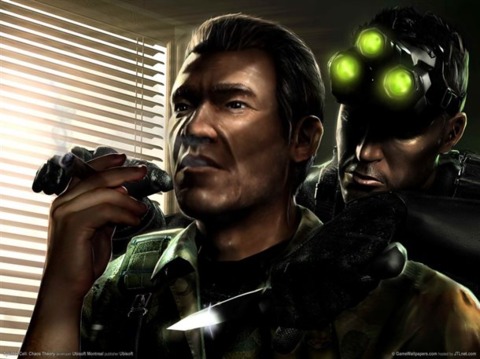
This is possibly the best feature of the game. The scenario I described above did not happen on the first go. In a more patient moment, I might have been able to pull that off - first try; sometimes, however, I’m in an impatient mood. Quicksaving allows me to save my hide and my time, circumventing the brutal checkpoints of the previous Splinter Cell entries. Also, sneaking around perfectly on the first go is nigh impossible. This is why Sam Fisher’s job doesn’t exist[4] – those folks would be dropping like flies in a room full of lye. While I love how utterly punishing the Splinter Cell game is, the quicksave function keeps my frustrations at arm’s length – just where I like them.
At the end of the day, this is a Splinter Cell game, just like the other two in the original trilogy. Each level is competently-to-well designed, and spatially balances the tensions of stealth with the frustration of failure quite well. The emphasis on staying in the shadows remains, as does a focus on slow, quiet movement. Despite the lack of innovation, this title executes upon the core ideas and themes of previous titles with far greater levels of success. I enjoyed my time with this game so much, that I forgive its few, minor flaws. Fair warning - the final 10 minutes of this game are... bad. That being said, the many great successes of this game far outweigh the problems I have with a few superfluous pieces of equipment, brief inconsistencies with the A.I., and a poorly thought-out finale. Ultimately, Chaos Theory is a game that demands your attention, and earns it.
10/10
[1] This makes me both happy and sad. God, do you even realize how much I like Michael Ironside’s voice? I finally watched Starship Troopers this year, and I flipped my LID when he walked on the screen. I would literally pay him to talk to me. Or sing Tom Waits covers. Either one.
[2] HAHAHA. Who am I trying to kid here? Certainly not you. No it hasn’t.
[3]… like novels I may have read as a teen at camp.
[4] But maaaaaan it would be cool if it did.
